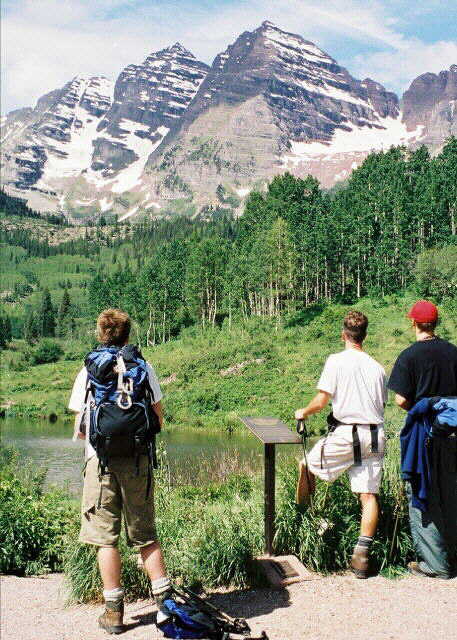| Links |
| Contact Us! |
| Equipment List |
| Camera and Film |
| Other Photos |
|
Introduction The Maroon Bells are often hailed as "the most photographed mountains in America." Their twin pyramids appear in television commercials, newspaper ads, western movies, puzzles, road atlases and coffee table books. Indeed, the Bells form one of the most spectacular vistas in the country, right up there with the Chicago skyline and the Tetons. So many people want to see the Bells, the Maroon Lake viewpoint is accessible only by bus during daytime hours. From the parking lot, a trail skirts along Maroon Lake for a few hundred yards. Eventually, the trail splits, providing two routes to the base of the Bells. Where the trail splits, there is a copper-colored sign on a little pedestal. The sign is entitled "The Deadly Bells" and is intended as a last warning to would-be climbers about the perils of wandering onto these peaks. The sign reads:
Jace was not happy with that sign. He had not liked the cemetery with 23 headstones at the foot of Chimborazo in Ecuador the previous year either. He emotes openly about stuff like this - saying aloud what every single one of us is thinking. All I could think about was how crazy I was to bring young people to the Bells ... especially a 17 year-old on his first climb.
The Bells got their "deadly" name in 1965 when 8 people died in five separate accidents. Predictably, every guidebook in existence talks about "rotten rock", "dangerous rock" and "inordinate risk of death". The rock is called "rotten" because it is metamorphic sedimentary mudstone, basically mud that has hardened into rock over millions of years. Unlike granite and limestone, mudstone breaks up easily. Even Dr. Tom Hornbein, veteran of the first American ascent of Mt. Everest in 1963 and conqueror of Everest's wicked West Ridge, warned me about the unusual danger of the Bells in an e-mail. So, forgive me, but I have to say this:
OK, enough of that. Let me tell you about our climb. In the spring of 2001, I talked to some young friends, Jace McAlister, then 21, Jake Collins, 27, Joey Hammmond, 17, and Brendan Anslinger, 22, about climbing the Bells. I had met them all giving astronomy programs or observations. They are all adventuresome souls and are, to a man, physically strong, adventurous, bright and endlessly humorous. I had climbed in Ecuador with Jake, Jace and Brendan in 2000 ... an incredible experience. Joey had never climbed before, but wanted to very badly. Joey is a talented multi-sport athlete, a superb water skier and snowboarder and a Golden Gloves boxer, so there was no doubt he could handle it. Brendan called me during a 30 mile bike ride and told me he could not make the Bells trip due to university and job commitments. DiShon Lutz, whom I had met through Jake, was only 16 at the time and had job and soccer team commitments. We chose the week of June 25-29, 2001, for our climb. There are two Bells, Maroon Peak (14,156 feet) and North Maroon Peak (14,014 feet). Some do not consider North Maroon to be a separate "fourteener" because there is less than a 300 foot drop between the two summits, so we decided to climb the taller of the two, Maroon Peak. Perspective makes it appear shorter from the Maroon Lake parking lot. Before the climb, we learned a lot from on-line trip reports and guidebooks, but we still had questions that needed answering as we began our climb. Hopefully, this article and the green-highlighted TIPS will answer any questions you may have if you are planning a Bells climb ... or at least a South Maroon Peak climb. If they do not answer your questions, feel totally free to contact any of us. Our equipment list appears at the end.
|

